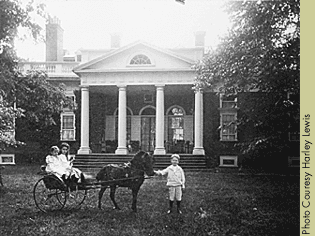Marc Leepson's Blog, page 3
February 13, 2024
February 2024
Saving Monticello: The Newsletter
The latest about the book, author events, and more
Newsletter Editor - Marc Leepson
Volume XXI, Number 2 February 2024
“The study of the past is a constantly evolving,never-ending journey of discovery.” – Eric Foner

TELLING JEWISH STORIES: That’s the title of an enlightening talk that OliviaBrown, a full-time tour guide at Monticello and a Historic InterpretationFellow at Monticello’s Robert H. Smith International Center for JeffersonStudies, livestreamed on January 26. It’s archived online at https://bit.ly/JewishStories
In her talk Olivia looked atthe history of Jewish people associated with Monticello and in Charlottesville duringand after Thomas Jefferson’s time, focusing on their relationship with thearea’s enslaved population. Naturally, that included Uriah P. Levy’s ownershipof Monticello from 1834 when he purchased the property to his death in 1862.
Olivia devoted the last fourth of her hour-long talk to Uriah Levy and detailsof his ownership of at least 19 enslaved people. She also mentioned Uriah’sbrother Jonas Levy (Jefferson M. Levy’s father), his devotion to the Confederatecause during the Civil War, and his purchase of one of his brother’s enslavedpeople in 1864—and Uriah and Jefferson Levy’s overseer at Monticello, JoelWheeler, who also was an enslaver.
“I wouldn’t characterize UriahLevy as ‘pro-slavery,’” Olivia said, “but he was someone who was participatingin and profiting from the institution of slavery. He could, so he did.”
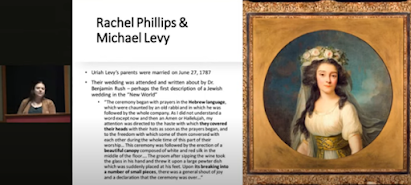
As I noted in SavingMonticello, Olivia pointed out that Uriah Levy purchased his first enslavedperson, Aggy Dickerson West, a cook, in 1835 a year after he bought theproperty from James Turner Barclay, who had purchased Monticello in 1831 from ThomasJefferson’s heirs, his daughter Martha Randolph and her son Thomas JeffersonRandolph.
As I did in the book, Olivia talked about what Uriah Levy’smuch-younger wife, Virginia Lopez Levy, had to say in the 1920s about theenslaved people at Monticello in words that can only be described aspatronizing and racist.
Here’s how I put it in thebook: Virginia Lopez Levy “loved spending time at Monticello. ‘How I did enjoygalloping over those hills around Monticello,’ she said in an interview justbefore she died in 1925 in her 90th year.” She went on to refer to the enslavedpeople there as “darkies,” including in this anecdote:
“The darkies were veryamusing. I remember one day accidentally coming across our cook, Aggy, in thedrawing room. She was standing in front of a figure of a woman in bronze,evidently comparing her arm with this figure. Finally, she ejaculated: ‘My arm’sa heap sight prettier dan dat are black woman!’”
Olivia pointed out that noone has uncovered any records indicating how Uriah Levy and Joel Wheelertreated their enslaved people on the mountaintop. But if you look at how enslaved people weretreated by others in Virginia, she said, “it’s likely they were being treatedin the same way” at Monticello.
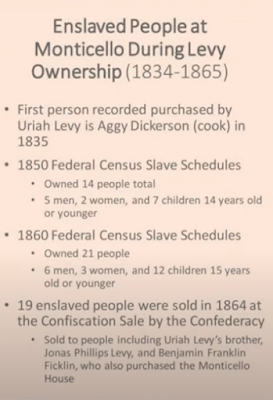
Her conclusion on the overallpicture of Jews and slavery in Monticello and Charlottesville: “Jewish peopleowned enslaved people and treated them the same way their non-Jewishcounterparts did. It wasn’t because of their Judaism that they owned slaves butdespite their Judaism.”
ASKENAZION BOARD: In the January newsletter Imentioned—as I did in the book and in countless talks I’ve given on SavingMonticello since it came out in 2001—that Uriah Levy’s great-great grandfather,Dr. Samuel Nunez, and his immediate family came to the U.S. on a ship from London,the William and Sarah, carrying 42 Sephardic Jews. It turns out that I assumed allthe emigrants were Sephardic Jews, and you know can happen when you assume.
Sharp-eyednewsletter subscriber Kerry Rosen, who gives tours at Mikveh Israel in Savannah,emailed to remind me that there were 34 Sephardicpassengers on the ship along with eight Jews “from Ashkenazi backgrounds. Weeven know their names: Benjamin Sheftall and family, Abraham Minis and family,and a single man, Jacob Yowel.”
Kerry is correct, as Iconfirmed by reading the famed Jewish-American genealogist Rabbi guide to the Minis Family papersheld at the William Breman Jewish Heritage Museum in Atlanta. This is Rabbi Stern's list of the eight Ashkenazim:
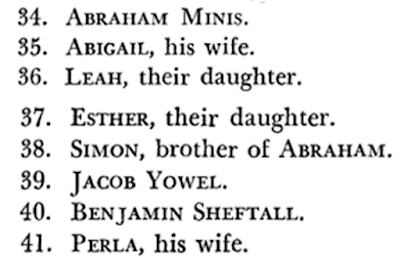
As the Minis Family papers collection notes: “The first generation ofthe Minis family to come to Georgia shores was Abraham (c.1694-1757) and hiswife Abigail (1701-1794) of German origin.
“Records indicate that theMinis family as well as the Sheftalls and one Jacob Yowell were Ashkenazim…. Theylanded in Savannah July 11, 1733, together with a number of Sephardic Jewishfamilies coming to the colony fromSpain and Portugal after a residence in England.”
AMELIAPRESIDING: Levy descendant RichardLewis recently sent me several images from his grandmother Fran Lewis’scrapbook, including a rare photograph of Amelia Mayhoff, Jefferson Levy’ssister who frequently acted as her bachelor brother’s hostess at Monticelloduring his 1879-1923 ownership. The photo (below) is from a September29, 1907, New York Herald society page article Richard kindly sent that reportedthat Amelia spent more than half the year “presiding over” Monticello, the family’s“historical residence.”
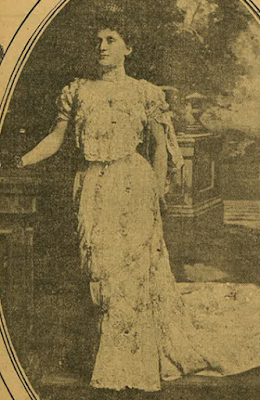
That society column item illuminates the social scene that Amelia and herbrother created at Monticello, which I cover in depth in Saving Monticello. In October 1907, as thearticle notes, the siblings hosted several events on the mountaintop for theBishop of London. Among the guests was FrancesEvelyn (“Daisy”) Greville (née Maynard), the Countess of Warwick ,a well-known Edwardian beauty, socialite, and writer.
Thelocal Charlottesville Daily Progress,which often covered social doings on the mountaintop, pointed out thatJefferson Levy was the countess’ “legal adviser.”
Laterthat month, 75 visitors from Brooklyn paid a visit to Monticello on their wayback from the Jamestown Exposition, a seven-month world’s fair-like event heldnear Norfolk to commemorate the 300th anniversary of the settlement ofJamestown in 1607.
EVENTS: I am almost finishing writing my next book, a slice-of-lifebiography of U.S. Navy Seaman Apprentice Doug Hegdahl, the lowest-ranking andyoungest American captured in North Vietnam and held prisoner there during theVietnam War, which will be published either in late November or early December.So, no events this month. I havetalks scheduled for March and later in the year. Fordetails them, check the Events page on my website: marcleepson.com/events
MARCLEEPSON.COM: Speaking of my which, I invite you to check out myrecently redesigned and updated website, which was born in 2001 in time for thepublication of Saving Monticello. I hope you’ll agree that the new siteis streamlined and reader friendly. It also includes a page for orderingautographed copies of my books. The image below is the centerpiece of the newlanding page.

My daughter, Cara Rose Alford, createdthe site through her design company, Allegory Art Consulting in Charleston,South Carolina. I recommend her work! You can learn more at allegoryartconsulting.com
GIFT IDEAS: For a personally autographed, brand-new paperback copy of Saving Monticello or the just-publishedhardcover of Huntland, go to the new page on my website https://bit.ly/BookOrdering or email me at marcleepson@gmail.com I also usually have a few used SavingMonticello hardcovers, and a stack of five of my other books: Flag: An American Biography; DesperateEngagement; What So Proudly We Hailed; Flag:An American Biography; and Ballad ofthe Green Beret.
January 7, 2024
January 2024
Saving Monticello: The Newsletter
The latest about the book, author events, and more
Newsletter Editor - Marc Leepson
Volume XXI, Number 1 January 2024
“The study of the past is a constantly evolving,never-ending journey of discovery.” – Eric Foner

I included a brief sketch ofthe life of Dr. Samuel Nunez as he came to be known in the United States (and is referred to in eighteenth century documents as Diogo Nunes Riberio, Samuel Riberio Nunez, Samuel Nunis,and Samuel Nunez Riberio) in SavingMonticello, along with the colorful, handed-down story about how he and hisSephardic Jewish family escaped the Portuguese Inquisition.
In recent years I’ve learnedmore details about what Dr. Nunez and his family went through during thehellish Inquisition and the details of their escape, including what I reported onin the September 2022 newsletter based on recent genealogical research by AlexBueno-Edwards.
Alex had just created adetailed, well-documented Dr. Samuel Nunes page on Geneanet, aEuropean genealogical database. In preparing the page, Alex relied heavilyon research done byArlindo Correia during a deep dive into the official Portuguese Inquisitionrecords. In 2012, Arlindo Correia uncovered a vast amount of materialabout the Nunes family’s Inquisition horrors, including new information about theirdaring, life-saving 1726 escape from Lisbon.

Tom Loftis uncovered more details aboutthe Nunez family saga with the help of a graduate student at Lisbon Universityand Rita Mayer Jardim, a Lisbon attorney who specializes in helping descendantsof Sephardic Iberian Jews attain Portuguese citizenship—as well as PortugueseJews in America: Escape from the Inquisition, a Portuguese book (seecover above) by historian Carla Vieira, who specializes in PortugueseSephardic history.
For “many generations, the Nunez familykept up its Jewish faith and practices in secret,” Tom wrote, “and some family membersmet a violent death at the hands of the inquisition.” That included Clara Nunez,who was burned to death in Seville, Spain, in 1632, and Isabel and Helen Nunez,who also were executed that year.
Dr. Nunez was born, as I noted in SavingMonticello, in Idanha-a-Nova, near Portugal’s eastern border with Spain. WhatI didn’t know was that he received his medical training in Plasencia and Salamancain Spain and at the Portuguese University of Coimbra, and began practicing inLisbon around 1698.
The family practiced Judaism in secret asDr. Nunez became a prominent physician in the Portuguese capital providing medicalcare to King Peter II (also known as Dom Pedro II), who reigned from 1648-1706,and even the Portuguese Grand Inquisitor, along with other prominent Dominican religiousfigures and Lisbon secular leaders.
Tom confirmed what I wrote in SM that theInquisition sent a spy into the Nunez household, and that he discovered thefamily were practicing Jews. On Saturday nights, Tom said, the family “retreatedto a synagogue in an underground part of [their large home], concealed by amovable bookcase in the library.”
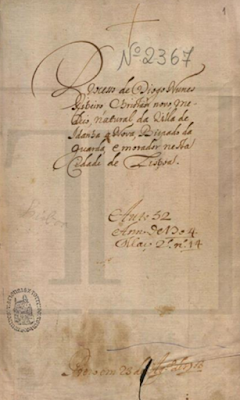
Tom reported that the graduate student found digitized official records of Dr. Nunez’s Inquisition Case, number 2367, “whichindicates that on August 23, 1703, prisoner Diogo Nunez Ribeiro was taken byAndre Lopes at the Palace of the Estaus, in the Rossio Square in Lisbon, at theentrance of the secret cells of the Inquisition” and was “charged withascribing to Judaism and encouraging associates to reject Christianity.”
Although several prominent peopletestified in his defense, Dr. Nunez broke under torture and confessed. OnSeptember 13, 1704, he was sentenced to “perpetual imprisonment,” whichamounted to house arrest. Plus, the state confiscated some of his assets and hewas forced to attend daily sessions at the Dominican Catholic Church designedto convert him to Christianity.
Two years later, Dr. Nunez “managed to regain some of his medicalinfluence and social contact,” Tom wrote. Between 1700 and 1735 some 1,500 PortugueseJews fled to Britain and the Netherlands. “After careful planning and afterliquidating his assets and sending the funds to trusted Jewish friends inLondon,” Tom wrote, Dr. Nunez engineered his family’s escape.
He and his family “went toChristian Church on a Sunday morning and then proceeded to the river shorelinelike any other Sunday,” Tom wrote. But instead of a leisurely afternoon stroll,the family rendezvoused with a British sea captain who spirited them off toLondon, leaving behind their “mansion, furniture, China, prestige, and security.”
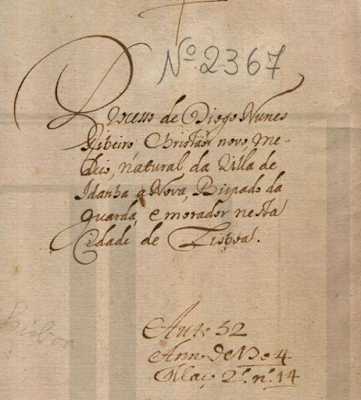
And, as I wrote in the book, when the Nunez family arrived in London they joined a colony of some6,000 fellow Sephardic escapees from the Spanish and Portuguese Inquisition.Soon after arriving, Dr. Nunez remarried his wife, Gracia (known as Rebecca) ina London synagogue that many other Sephardic refugees joined. The family formallyconverted to Judaism in London and Dr. Nunez and his two sons, as part of theconversion, underwent the rite of ritual circumcision.
Agroup of wealthy London Jews paid for the passage of a chartered ship thatsailed from London in the summer of 1733 with 42 Sephardic Jews aboard, includingthe Nunez family. After a rough voyage, the ship, the William and Sarah, landed in Savannah, Georgia, on July 11, 1733,six months after James Oglethorpe established the colony named after hispatron, King George II. At the time, there were fewer than a thousand Jewsliving in the 13 British colonies.
DR.KAMENSKY: Dr.Jane Kamensky will become the Thomas Jefferson Foundation’s next president onJanuary 15. I hope to have an interview with the former Harvard Universityhistorian, focusing on the Levy family’s stewardship of Monticello, in nextmonth’s newsletter.
In last month’s newsletter, mycorrection about Frances Wolff Levy Lewis being the eldest (not thesecond-eldest) of the four daughters of Jefferson Levy’s brother Louis NapoleonLevy, I wrote that Nancy Hoffman (who emailed about the error) was Fran’sdaughter. Nancy, in fact, is Fran’s niece. I also mistakenly said thatNancy, who was born in 1930, was the last of L. Napoleon. Levy’s living children;she is the last of his living grandchildren.
Here’s a snapshot from the Malcom Stern’s pioneeringbook, The American Jewish Families: 1654-1988, with the info on Nancy’s threeaunts and her mother Alma:

EVENTS: I am still at work on my next book, a slice-of-life biography of U.S.Navy Seaman Apprentice Doug Hegdahl, the lowest-ranking and youngest Americancaptured in North Vietnam and held prisoner there during the Vietnam War, whichwill published next spring. So, no events this month. For details on future book talksand other author events, check the Events page on my website: marcleepson.com/events
MARCLEEPSON.COM: Speaking of the website, with the help of a terrific web designer,I have just redesigned and updated mine, which was born in 2001 in time for thepublication of Saving Monticello. I hope you’ll agree that the site isstreamlined and reader friendly. It also includes a page for orderingautographed copies of my books. The image below is the centerpiece of the newlanding page.
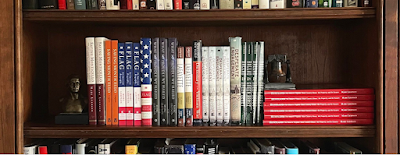
My daughterCara Rose Alford created the site through her design company, Allegory ArtConsulting in Charleston, South Carolina. Check out her website, allegoryartconsulting.com
GIFT IDEAS: For a personally autographed, brand-new paperback copy of Saving Monticello or the just-publishedhardcover of Huntland, go to the new page on my website https://bit.ly/BookOrdering or email me at marcleepson@gmail.com I also usually have a few used SavingMonticello hardcovers, and a stock of new copies of five of my other books:Flag: An American Biography; DesperateEngagement; What So Proudly We Hailed; Flag:An American Biography; and Ballad ofthe Green Beret.
December 7, 2023
December 2023
Saving Monticello: The Newsletter
The latest about the book, author events, and more
Newsletter Editor - Marc Leepson
Volume XX, Number 12 December 2023
“The study of the past is a constantly evolving,never-ending journey of discovery.” – Eric Foner

THE DOC: When’s the documentary going to beavailable? I’ve heard that question countless times since Steven Pressman’s terrificfilm, “The Levys of Monticello,” began screening at more than ahundred film festivals around the country last year. My answer: As soon as Iknow, I’ll tell the world.
So, I’m extremely happy to report that twoweeks ago I had an email from Steve letting me know that his award-winning filmbegan streaming on November 24 on several of the big online platforms,including Amazon Prime, Google Play, and Apple iTunes.
With scores of historic images, “TheLevys of Monticello,” which was inspired by Saving Monticello, creativelyand effectively tells the story of Uriah and Jefferson Levy’s 89-yearstewardship of Thomas Jefferson’s Monticello with input from a raft of great on-screencontributors.
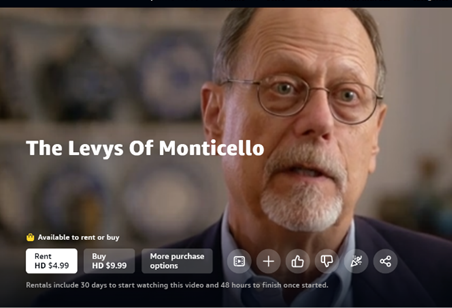
That includes including Susan Stein,Monticello’s longtime curator; Dr. Dan Jordan, the historian and former Thomas JeffersonFoundation president; University of Virginia Professor Emerita Dr. PhyllisLeffler; the renowned Brandeis University Professor of Jewish-American history,Dr. Jonathan Sarna; Niya Bates, the former director of African American historyand the Getting Word African American Oral History Project at Monticello; VirginiaCommonwealth University Emeritus History Professor Dr. Mel Urofsky, Levy Familydescendants Harley Lewis and her son Richard Lewis; and yours truly. So, now’sthe time to watch the film from the comfort of your favorite movie watchingvenue—and to tell everyone you know about it!
DR.KAMENSKY: TheThomas Jefferson Foundation announced in October that Jane Kamensky will becomethe organization’s next president, starting January 15. Dr. Kamensky is comingsouth from Massachusetts, where she has been an American History Professor atHarvard University since 2015 and also has headed the Schlesinger Library on the History of Women in Americaat Harvard Radcliffe Institute.
We realize Dr. Kamensky isextremely busy as she makes the move to Virginia and assumes the leadership ofthe Foundation, but we hope to sit down with her for an interview soon andreport on it in next month’s (or February’s) newsletter. I’m very much lookingforward to hearing her take on the history of Monticello after Thomas Jeffersondied, especially Uriah and Jefferson Levy’s 89-year stewardship.
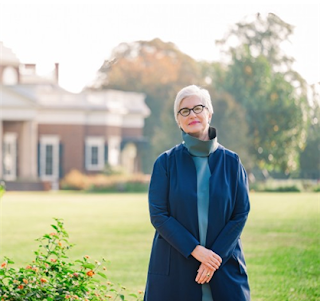
FOUNDATION HISTORY: A hundred years ago, on December 1, 1923, the newlyformed Thomas Jefferson Memorial Foundation (now the Thomas JeffersonFoundation) sealed the deal for its purchase of Monticello from JeffersonMonroe Levy. The former New York City congressman and big-time real estate andstock speculator had owned Monticello for 44 years, and—like his uncle, UriahLevy—had restored, repaired, and preserved the house and grounds after it had falleninto serious disrepair during the 17-year legal wrangling (from 1862-79) as familymembers challenged Uriah’s will in which he left Monticello to the people of theUnited States to be used as an agricultural school for the orphans of NavyWarrant Officers.
When he signed the title of the property overto the Foundation on December 1, 1923, in New York City, Jefferson Levyreceived a down payment of $100,000 of the $500,000 purchase price.
TheodoreFred Kuper, the Foundation’s first director, who was at the closing table, laterdescribed the scene: “The cash and the bonds and mortgage were delivered toLevy, and Levy signed the deed conveying full title to the property and allbelongings to the Foundation,” Kuper said.
“Thiswas a very emotional scene and he burst out crying. He said that he neverdreamt that he would ever part with the property.
Threemonths later, on March 6, 1924, at his home on East 37th Street inNew York City, Jefferson Levy died of heart disease, five weeks short of his 72ndbirthday. He is buried in Beth Olom Cemetery in Queens, in the Levy family plotnear his illustrious uncle.
****************
The Foundation has marked itscentennial this year with a series of ceremonial events. The latest, in late November,was a fact-filled livestream presentation by Ann Lucas, Monticello’s SeniorHistorian Emerita, titled “The Centennial of the Thomas Jefferson Foundation:100 Years of Education and Preservation.”
In in, Ann Lucas mentionedthe stewardship of the Levy family as she detailed the Foundation’s monumentalwork preserving and restoring Monticello over the decades and educating thepublic about Thomas Jefferson and his Essay in Architecture. You can watch thelivestream online at https://bit.ly/TJFLiveStream
HUNTLAND: My new book, Huntland: The Historic Virginia Country House, the Property, and ItsOwners, has just been published. My tenth book, it’s my second househistory, following the footsteps of SavingMonticello.
Huntland, inMiddleburg, Virginia, was built in 1834, has had several memorable owners and visitors(including Lyndon Johnson when he was Senate Majority Leader and VicePresident), and a triumphant 21st century historic preservation ending.
TheUniversity of Virginia Press is marketing and distributing the book. It’s availableonline at U-Va. Press’s website, on Amazon, and through local bookstores.

In lastmonth’s newsletter, I wrote that Francis (Fran) Wolff Levy Lewis was “thesecond-eldest” of the four daughters of Jefferson Levy’s brother Louis NapoleonLevy and his wife Lillian. Newsletter subscriber—and Fran’s niece—Nancy Hoffmanemailed to let me know that her aunt actually was the oldest daughter. Nancy,who was born in 1930, is the last of L. Napoleon Levy’s living grandchildren.
EVENTS: I am still working on my next book, a slice-of-life biography ofDoug Hegdahl, the lowest-ranking and youngest American captured in NorthVietnam and held prisoner there during the Vietnam War scheduled to bepublished in the spring of 2025. So, no events this month. For details on future talks, checkthe Events page on my website: https://bit.ly/NewAppearances
GIFT IDEAS: For a personally autographed, brand-new paperback copy of Saving Monticello or the just-publishedhardcover of Huntland, e-mail marcleepson@gmail.com
I also usuallyhave a few used Saving Monticello hardcovers, and a stock of new copiesof five of my other books: Flag: AnAmerican Biography; Desperate Engagement; What So Proudly We Hailed; Flag: An American Biography; and Ballad of the Green Beret.
The SMNewsletter on Line: You can read back issues of thisnewsletter at http://bit.ly/SMOnline
November 7, 2023
November 2023
Saving Monticello: The Newsletter
The latest about the book, author events, and more
Newsletter Editor - Marc Leepson
Volume XX, Number 11 November 2023
“The study of the past is a constantly evolving,never-ending journey of discovery.” – Eric Foner

FRAN’S YESTERDAYS: TheJune 2020 newsletter included excerpts about Monticello in the early 20thcentury from “Fran’s Yesterday,” a short, unpublished memoir that Levydescendant Frances Wolff Levy Lewis wrote in 1960.
Fran Lewis was the second-eldest of the four daughtersof Jefferson Levy’s brother Louis Napoleon Levy and his wife Lillian HendricksLevy. She was born on January 19, 1893, in New York City and married HaroldLewis in February 22, 1916. They had three children, including Harley Lewis,the Levy Family descendant who was a tremendous help to me when I wasresearching Saving Monticello.
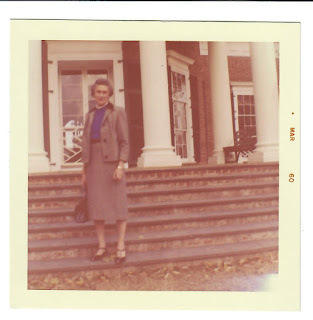 Fran Lewis at Monticello in 1960
Fran Lewis at Monticello in 1960Three years ago, Harley’s son Richard Lewis sent me two pages of the memoir in which his grandmother described visiting Monticello as a child with her siblings and parents. A few weeks ago, Richard kindly sent me the entire memoir and a short essay Fran wrote about visiting Monticello in 1908 when she was 15.
Whatfollows are excerpts about the family and Monticello that weren’t in the June2020 post or in SM. Fran wrote in the memoir that her father,L. Napoleon Levy, “came from a large and colorful family,” noting that one ofthe most colorful characters was her grandfather Jonas Levy, one of Uriah’sbrothers. She was right about the mercurial Jonas Levy, who spent most of hisadult life, as Fran put it, as a sea captain. She went on describe what theperipatetic Jonas Levy (1807-83) did after running away from the family home inPhiladelphia at 13 and showing up in New York City where his mother, Fanny, wasvisiting other family members.
Fanny Levy didn’t take kindlyto her young son making his way from Philadelphia to New York and “boxed hisears,” as Fran put it. So young Jonas abruptly left, but didn’t go back home. Instead,as family lore had it, he signed up as a cabin boy, Fran wrote, on “a sailingboat bound for S. America and was not seen by his family for 7 years.”
Fran Lewis then went on todescribe her Uncle Jeff in not exactly flattering words. For one thing, shesaid that the lifelong bachelor had little use for his young nieces duringvisits with their parents. When the family showed up at Jefferson Levy’s largetownhouse on East 34th Street, she said. “I don’t think he was atall interested in greeting” us, Fran remembered. And although her uncle was “avery wealthy man in those days, we never received anything of value from him orany gifts on birthday days.”
She pointed out that UncleJeff was “entirely different from my father,” even though the brothers practicedlaw together and were real estate investor partners. One example: L. NapoleonLevy thrived in the New York real estate business, while his brother, aboom-and-bust speculator, died about $2 million in debt.
Fran went on to say that she’dheard that her father wrote most of Jefferson Levy’s speeches during his threeterms as a Congressman from NYC, and that Uncle Jeff’s grammar was “poor.” Shesaid he always “gave the impression of being a [VIP], which he probably was.Especially in the Waldorf Astoria, where he was well known and where he gavemany lavish parties.”
***************
Fran Lewis wrote an essay she called “The Approach to Monticello” when she wasa student at the all-girls Jacobi School on the Upper West Side, founded in1896 by Laura Jacobi, now known as the Calhoun School.
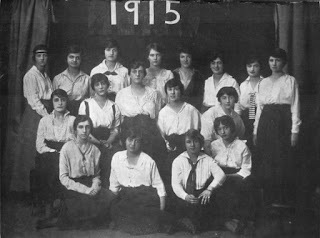 Jacobi School for Girls Class of 1915
Jacobi School for Girls Class of 1915In the essayshe evocatively describes what happened after she and her family arrived bytrain in Charlottesville from New York City for a visit to Monticello in June 1907.
As the train pulled “slowly out ofthe Charlottesville station,” young Fran wrote, “a large phaeton, drawn by apair of fine beautiful horses,” pulled up to take them to Monticello. Thefamily piled in and the open carriage made its way through the town (or“village,” as Fran put it) of Charlottesville and then onto a “very rough,muddy road” on the outskirts of town. Writing in the present tense, she notedthat the carriage “rattles and jolts over the ruts and stones.”
A few mileslater, as the sun was setting over the Blue Ridge Mountains, the carriage beganto climb up to Monticello. Just as they started up the steep road, the carriagecrossed a “quiet and peaceful” small creek and Fran remembered times when itwas “a roaring torrent, carrying great trees and small huts along with it.”
The road was better that day, but“very steep” and a “heavy pull” for the “strong Virginia horses.” On the wayup, they encountered a hay cart drawn by a pair of oxen driven by an olderAfrican American man who smiled and tipped his cap as they passed.
The horsessoon grew “tired and thirsty,” she wrote, so the carriage stopped and they drankthe “clear, cold water coming form a natural spring” on the side of the mountain.
The Levyssoon reached Monticello’s “pretty brick” Gate House, tended by Eliza ToliverColeman, whom Fran called “Aunt Liza,” and who swung “back the great gates forus to pass through.”
Then came a scaryride up a “curved and steep” road aside “a seemingly bottomless ravine” on theway to the house. Eliza had rung the large Gate House bell, “telling travelerson the top of the mountains not to go down,” Fran said, “as it is very dangerous for two vehicles to pass on such a narrow road.”
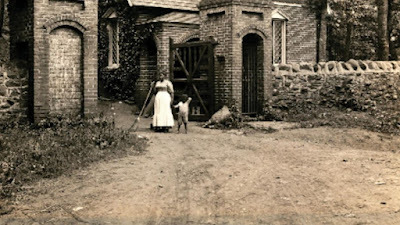 Eliza Coleman and a child at the old Monticello Gate House
Eliza Coleman and a child at the old Monticello Gate HouseAs theyneared the Jefferson Family cemetery (visitorsthen drove up to the house the opposite way they do now; that is, passing by thesmall graveyard before driving along Mulberry Row). silence “dropped overeverything,” Fran wrote, “never have I heard such stillness. The echo of thehorses’ hoofs on the stony road and the occasional cry of a peacock are theonly sounds.”
They passed the graveyard, where the headstones “looked white and ghostly”in the twilight. Then the refreshed horses ran “quickly across the lawn”heading for the East Front of the house. “Through the windows the soft light ofthe lamps seems to welcome us,” Fran wrote.
“We go onpast the rustic [long gone] fence, and the sweet scent of the honeysuckle whichis twined around it, is blown gently towards us. We give a long whistle. Thedogs begin to bark and an answering whistle comes back. On we go around thelarge lawn.
“Thecarriage stops in front of the great mansion; we are quickly helped to alightand taken up the long lawn. The doors of the house are thrown open, showing theGreat Hall inside, and we enter amid the barking of the dogs and hearty greetingsof the family.”
Fran Lewis, her sister Agnes, and their cousin Monroe Levyon the West Lawn during an earlier visit, circa 1902
DR. KAMENSKY: The Thomas Jefferson Foundation announced in Octoberthat Jane Kamensky will become the organization’s next president, startingJanuary 15 next year. Dr. Kamensky, aHarvard history professor who also directs Schlesinger Library on the Historyof Women in America at Harvard Radcliffe Institute, is just the secondhistorian to lead the nonprofit that has owned and operated Monticello since1923, and the second woman to hold that position.
Dr. Kamensky taught at Brandeis University and Brown University before joiningHarvard’s History Department.
Dan Jordan, a former historyprofessor at Virginia Commonwealth University, headed the Foundation from 1985-2008;Leslie Greene Bowman succeeded Dr. Jordan and resigned in April. GardinerHallock has been serving as interim President since then.
“We are thrilled to welcomeDr. Kamensky, who shares our belief that Monticello plays a pivotal role inilluminating the enduring ideals and contributions of Thomas Jefferson andtelling the stories of those who built and worked at this incredible World HeritageSite,” said Tobias Dengel, who chairs the Foundation’s Board of Trustees. “Dr.Kamensky brings more than 30 years of deep expertise as a distinguishedacademic at some of the world’s leading institutions and has displayed acontinued commitment to civic education and engagement to bring people together.”
We hope to have an interview withDr. Kamensky (below) in next month’s newsletter. It’ll focuse on her take on the historyof the house after Thomas Jefferson died—not coincidentally, the topic of SavingMonticello.
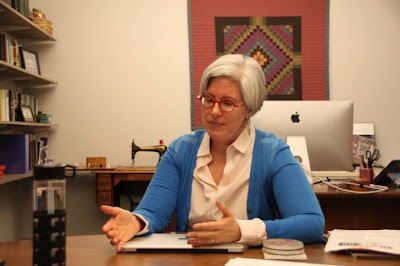
HUNTLAND: My new book, Huntland: The Historic Virginia Country House, the Property, and ItsOwners, has just been printed and copies are being shipped to theUniversity of Virginia Press, which will begin marketing and distributing thebook by the end of the month. My tenth book, it’s my second house history,along the lines of Saving Monticello.
Huntland, in Middleburg, Virginia, was built in1834, and has lots of history, memorable owners and visitors (including LyndonJohnson when he was Senate Majority Leader and Vice President), and atriumphant 21st century historic preservation story.
The book will be availableonline at U-Va. Press’s website and through local bookstores. Meanwhile, here’sthe link for the U-Va. Press Fall Catalog with more info about the book: https://bit.ly/U-VaPressHuntland
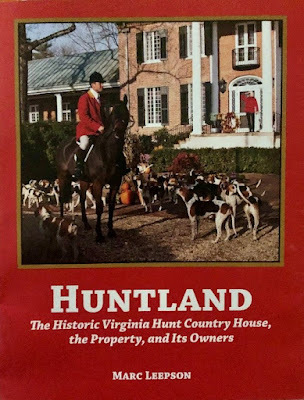
EVENTS: Still hard at work on my next book, the slice-of-life biography ofDoug Hegdahl, the lowest-ranking and youngest American captured in NorthVietnam and held prisoner there during the Vietnam War. So, no events thismonth. For details on future talks, check the Events page on my website: https://bit.ly/NewAppearances
GIFT IDEAS: For a personally autographed, brand-new paperback copy of Saving Monticello, please e-mail marcleepson@gmail.com I also havea few as-new, unopened hardcover copies, along with new copies of my otherbooks: Flag: An American Biography;Desperate Engagement; What So Proudly We Hailed; Flag: An American Biography; and Ballad of the Green Beret.
October 6, 2023
October 2023
Saving Monticello: The Newsletter
The latest about the book, author events, and more
Newsletter Editor - Marc Leepson
Volume XX, Number 10 October 2023
“The study of the past is a constantly evolving,never-ending journey of discovery.” – Eric Foner

‘100 YEARS’ EXHIBIT: Theyear 1923 was a landmark one in Monticello’s long history. That was the yearthat Jefferson Levy—who had owned Thomas Jefferson’s Essay in Architecturesince 1879, and had repaired, preserved, and restored the house and grounds—soldthe property to the fledgling Thomas Jefferson Memorial Foundation. Thatnonprofit had formed in March with the express purpose of purchasing andrunning Monticello.
The Foundation has now owned and operated Monticellofor a hundred years and has commemorated its centennial with events throughoutthe year. That includes a terrific exhibit at the Foundation’s JeffersonLibrary, dedicated in 2002 a stone’s throw from Monticello. It’s called “100Years of the Thomas Jefferson Foundation,” and is on display at the Library andonline with an informing, and evocative virtual tour.
The exhibit was curated anddesigned by Anna Berkes, the Library’s Manager of Public Services andCollection Development; Megan Brett, the Manager of Collections Processing andDigital Initiatives; retired Monticello guide par excellence BillBergan; and Library volunteer Jeni Crockett-Holme, under the direction ofEndrina Tay, the Foundation’s Fiske and Marie Kimball Librarian.
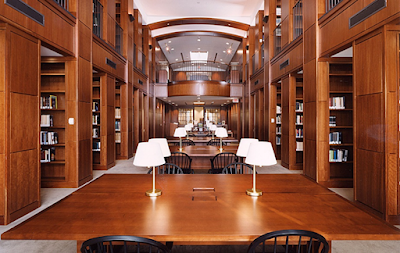 Jefferson Library Main Reading Room
Jefferson Library Main Reading RoomOn a personal note, all ofthe above folks, and many others at the Foundation, have been strong supportersof my work since the day in 1997 that I came to the Mountaintop to do researchfor what would become Saving Monticello.
Here’s the link for thevirtual tour: https://bit.ly/JeffLibraryExhibit And here’s the link for the Jefferson Library’swebsite with info about visiting hours and access to its extensive collectionof material: https://www.monticello.org/research-education/jefferson-library
CENTENNIALYEAR CHRONOLOGY: As a date-obsessed, linearly-oriented historian, I felt a burningneed to put together a chronology of the Foundation’s 1923 highlights. Also,FYI: the Thomas Jefferson Memorial Foundation dropped the M-word in 2000.
February 1923 - Gregory Doyle of MountainLakes, New Jersey, sets up a meeting at the Vanderbilt Hotel in New York Cityto discuss forming a new private, nonprofit to purchase Monticello.Thomas Jefferson Randolph IV, a great-great grandson of his namesake, representingVirginia, journeys north to meet with several wealthy and influential New YorkCity lawyers, including Virginia-born Stuart Gatewood Gibboney.
March3 - Afollow-up meeting is held meeting at the Lawyers’ Club in New York City atwhich the Thomas Jefferson Memorial Foundation is born. Gibboney assumesthe presidency of the group. Theodore Fred Kuper, a young New York City lawyerwho had immigrated to this country as a young boy from Russia in 1891, is madenational director with a promised salary of $50 a week.
Early April – The Foundation announcesthat an agreement has been reached with Jefferson Levy to purchase Monticelloand that it would soon launch a nationwide movement to raise $1 million topurchase and administer the property.
April13 – On the180th anniversary of Jefferson’s birth, a Certificate ofIncorporation, or charter, of the Thomas Jefferson Memorial Foundation, Inc. isfiled in the office of New York’s Secretary of State in Albany. A certifiedcopy is filed that day in the County Clerk’s Office in New York City where the Foundationwould set up its offices.
The Foundation’s Board of Directors includes U-Va. President Edwin Alderman, StuartGibboney, Moses Grossman, and Maud Littleton—the woman who infamously tried towrest control of Monticello from Jefferson Levy; she would resign the nextmonth. Also on the Board: Nancy Langhorne Astor, better known as Lady Nancy Astor, anative Virginian who was the first woman to serve in the British House ofCommons, and her sister Irene Langhorne Gibson of Richmond (below), the original GibsonGirl of the 1890s, the famously beautiful model for hundreds of drawings by herequally famed artist husband Charles Dana Gibson.
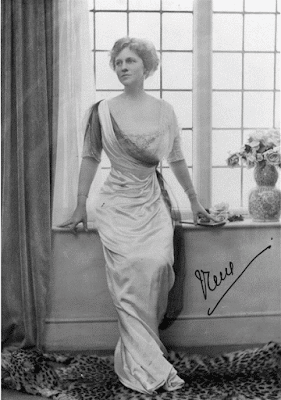
FormerPresident Theodore Roosevelt, also is named to the Board, as well as Governor Lee Trinkleof Virginia and Felix M. Warburg, the extremely wealthy German-born Jewish NewYork banker and philanthropist who had tried to purchase Monticello for the nation several years before the Foundation wascreated.
May 31 - The Foundation and Jefferson Levy sign an option for the purchase ofMonticello, the 640 acres around it, and all of the furniture and furnishingsinside. The price: $500,000. On that same day the Foundation is “domesticated”in Virginia, giving it the legal right to transact business in that state.
June 8 -The Foundation Board unanimously approves the contract.
June30 - The deedof trust is executed. Jefferson Levy gives the Monticello Association (theorganization of Jefferson descendants that owns the family graveyard atMonticello) an additional half acre of land adjacent to the cemetery to be usedas a graveyard for other Jefferson descendants.
July14 - The Foundationissues a statement making a public appeal for $1-million for the purchase priceand for “the proper and effective maintenance of Monticello as a nationalmemorial throughout all time.”
December1 – JeffersonLevy receives the first mortgage payment and signs the title of Monticello overto the Foundation in New York City. Fred Kuper described the scene:
“Thecash and the bonds and mortgage were delivered to Levy, and Levy signed thedeed conveying full title to the property and all belongings to the Foundation.This was a very emotional scene and he burst out crying. He said that he neverdreamt that he would ever part with the property.”
December3 - TheFoundation’s Deed of Conveyance is signed in the Albemarle County Clerk’s officein Charlottesville. The news makes the front page of the next day’s New York Times. Soon thereafter,Monticello is open to the public. The Foundationhires two local African American men, Benjamin Carr and Oliver Johnston, toguide visitors through the house.
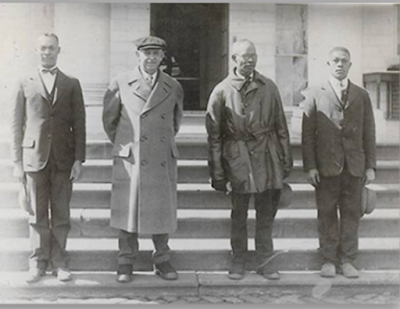
Thomas Rhodes (second fromleft) Monticello's long-time superintendent, whom Jefferson Levy hired soonafter he took possession of the property in 1879, in the early 1920s with threehouse tour guides: Robert Sampson, William Page, & Benjamin Carr
March6, 1924 - Athis home on East 37th Street in New York City, Jefferson Levy diesof heart disease, five weeks short of his 72nd birthday.
1940. The Foundation pays offthe mortgage.
THE HUNTLAND BOOK: The University of Virginia Press will bedistributing and marketing my next book, Huntland:The Historic Virginia Country House, the Property, and Its Owners, whichwill be coming out in just a few weeks. My tenth book, it’s my second househistory, along the lines of SavingMonticello.
Huntland, in Middleburg, Virginia, was built in1834, and certainly has lots of history, memorable owners and visitors(including Lyndon Johnson when he was Senate Majority Leader and VicePresident), and a triumphant twenty-first century historic preservation story.
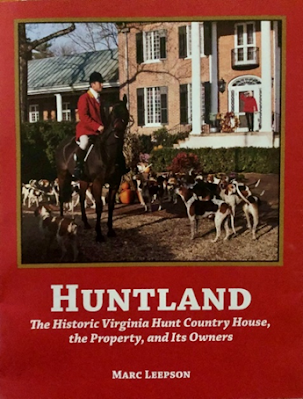
Here’s the link for theU-Va. Press Fall Catalog with more info about the book: https://bit.ly/U-VaPressHuntland By the endof the month, it’ll be available in bookstores, on the U-Va. Press website, andthrough the big online booksellers.
EVENTS: On Sunday, October 22, I’ll be doing a talk on SavingMonticello and a book signing as part of Hadassah Charlottesville’s “Jewish in Virginia – Our Past, Our Present, Our Future”event at the Hillel Brody Jewish Center at the University of Virginia.
The event runs from 9:30 a.m.to 3:00 p.m. and includes a continental breakfast and buffet lunch—and liveKlezmer music. Registration closes on October 13. To register, go to: https://bit.ly/HillelHadassah
For details on events later this year, check the Events page on mywebsite: https://bit.ly/NewAppearances
GIFT IDEAS: For a personally autographed, brand-new paperback copy of Saving Monticello, please e-mail marcleepson@gmail.com
I also havea few as-new, unopened hardcover copies, along with new copies of my otherbooks: Flag: An American Biography;Desperate Engagement; What So Proudly We Hailed; Flag: An American Biography; and Ballad of the Green Beret.
September 7, 2023
September 2023
Saving Monticello: The Newsletter
The latest about the book, author events, and more
Newsletter Editor - Marc Leepson
Volume XX, Number 9 September 2023
“The study of the past is a constantly evolving,never-ending journey of discovery.” – Eric Foner

ISABELLA & MARCUS: In my ongoing quest to researchthe Levy and Nunez families, I recently came across an evocative image I’dnever seen before. It’s a circa 1859 daguerreotype displayed on the John L.Loeb, Jr., Database of Early American Jewish Portraits website. It’s identifiedas a photographer’s studio image of seven-year-old Jefferson Monroe Levy (incurls and the dress-like shirt on the right) and his nine-year-old sister Isabella,and is in the collection of the American Jewish Historical Society in New YorkCity.
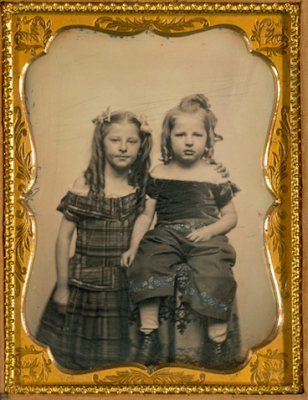
Asidefrom the thrill of seeing what appears to be a photograph of Jefferson Levy asa child, coming across the image also piqued my curiosity about Isabella, whomI mentioned only briefly in Saving Monticello. To wit: that she wasknown as “Belle,” was the oldest of Jonasand Fanny Levy’s five children, married Marcus Ryttenberg, and often visited her younger brotherat Monticello after her son Clarkson Potter Ryttenberg was born in 1881.
Accordingto the late Malcolm Stern’s authoritative The First American Jewish Familiesgenealogies, Isabella was born onDecember 12, 1849, in Vera Cruz in Mexico where her peripatetic father, a shipcaptain, and his wife Fanny were living. Her younger sibling Jefferson Monroe, came along onApril 15, 1852, when the family was living in New York City. Two years later,their second son, Louis Napoleon, was born in NYC. Then came Amelia, born inWashington, D.C., on June 1, 1862; and Mitchell Abraham Cass, born 13 monthslater in New York.
Ihave since learned that on January 15, 1879, when she was 30 years old, Belle marriedMarcus Ryttenberg (mea culpa: I spelled his name incorrectly—Ryttenburg—inSaving Monticello), who was born in Russian-occupied Poland in January 1846and emigrated to the U.S about 20 years later with his family. The wedding tookplace in New York City. Just two months later, another Levy family big eventtook place: On March 29, 1879, Isabella’s brother Jefferson took control ofMonticello by buying out his uncle Uriah Levy’s other heirs after a 17-yearlegal battle over who would inherit the property.
Marcusand Belle had a son they named Clarkson Potter Ryttenberg in 1881. The familylived in several places in New York City, moving in the nineteen-teens to alarge townhouse at 17 E. 37th Street, between Fifth and MadisonAvenues, less than a block from what is today the Morgan Library and Museum,the former home of J.P. Morgan. It also happened to be where Jefferson Levylived.
It'slikely that Isabella moved in with Jefferson Levy (a bachelor) because MarcusRyttenberg spent most of his time, mainlyin the fall and winter, in the small city of Sumter in central South Carolina, about100 miles northwest of Charleston. Marcus ran J. Ryttenberg & Sons, aflourishing dry goods store in Sumter, along with two other family businesses.
Marcus, his father Joseph,older brother Harry, and younger brother Abe had fled Poland and settled in Sumterin the late 1860s, mostly likely in 1867, just two years after the end of the AmericanCivil War.
According to an 1889 article in the local newspaper, The Watchman andSouthron, Joseph Ryttenberg moved to Baltimore in 1870 and his son Marcus,“the first member of this family to live in Sumter, is credited with beginningthe business here.”
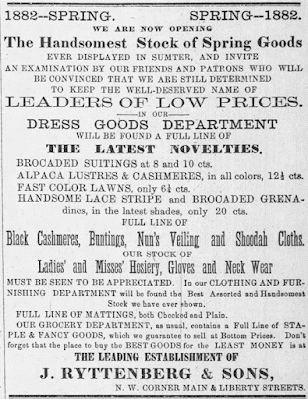
The store, as one of itsfrequent local newspaper advertisements put it—carried an “elegant line of DryGoods, Notions, Carpets, Cloaks, Shoes, Clothing and Groceries,” much of itbrought in from New York. By 1888, the “mammoth establishment” was “by far,”another ad proclaimed, “the largest business of any house in Sumter.”
The Ryttenbergs, whoworshipped at Temple Sinai, a reform synagogue in Sumter, also owned their ownbrickyard on the outskirts of Sumter. “Known as the Sumter Brick Yard,” it was“one of the leading industries of the Sumter community in 1890,” the local newspaperarticle reported. “The brick produced was used by numerous individuals inbuilding the city. The Ryttenbergs shipped their bricks to all points via arailroad which had constructed a branch to the yard in order to expedite theloading of the shipments. The brick yard at one time had nearly one millionbricks on hand for sale.”
One other thing about the Ryttenbergs andSumter. Researching the family took me to the 1880 U.S. Census, which reportedthat the Marcus—listed as a Drygoods Merchant—and Isabelle, “Keeping house,”were living in what must have been a large house on Main Street in Sumter, alongwith two adult servants and the seven-year-old daughter of one of them. Then Isaw something shocking.
Asyou can see from the image below, the Ryttenberg Family also included an theirinfant son, whom they named Jefferson L. Ryttenberg after her brother. The boywas born in New York City in November 1879, and there is no trace of him in anyCensus, genealogy, or other record after 1880, leading to the only conclusionthat the child died that year.

Marcus Ryttenberg diedsuddenly of a heart attack in Sumter on September 21, 1906. He was 50 years oldand the family shipped his body by train to New York City for burial. Isabelladied on July 7, 1925, and is buried at Beth Olom Cemetery in Queens, where herbrother Jefferson Levy, uncle Uriah Levy and other family members are buried.
THE PIER MIRRORS: Only a handful offurniture and furnishing in Monticello today have been in the house since Thomas Jefferson’s time. Theyinclude the famed seven-day Great Clock framing the door ofthe Entrance Hall, the ladder Jefferson designed to wind the clock, and thestriking pier mirrors also in the Entrance Hall.
Jefferson purchased themirrors when he served as U.S. Minister (Ambassador) to France from 1785-89,and had them shipped to Virginia in 1790. They were installed in the Parlor’sEntrance Hall sometime before 1900 and have been there ever since.
I mention the mirrors severaltimes in Saving Monticello, as visitors throughout the 19thcentury and into the early 20th century often commented on them. Theyalso played a role in the legal wrangling over what conveyed with the sale ofMonticello by James Turner Barclay to Uriah Levy in 1834. Barclay claimed themirrors and the Great Clock were his. Levy sued, saying they should be part ofthe sale. The matter was not settled until two years later when the sale closedand the parties agreed that clock and pier mirrors would stay in the house.
Ialso reported that in 1903, Jefferson Levy told a newspaper reporter inWashington that the architects then in charge of remodeling the White House hadasked to buy the mirrors.
“Ireplied that I did not feel at liberty to part with them, even for so laudablea purpose as letting them go to the White House,” Levy said.
“Iwrote to the architects saying that I had no objection to having the mirrorscopied, and I understand that this will be done. The mirrors at Monticello arebeautiful specimens of the Louis XVI period, and were purchased by Jefferson inFrance.”
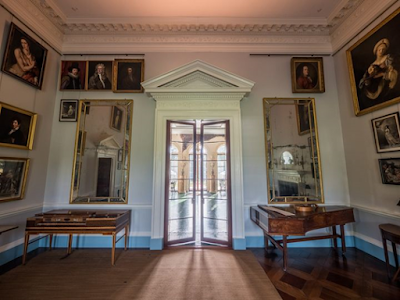
Thenext time you’re in Monticello’s Parlor be sure to stop for a minute and admirethose historic mirrors—not to mention the fully preserved and functional GreatClock.
THE HUNTLANDBOOK: The University of Virginia Press will be distributing andmarketing my next book, Huntland: TheHistoric Virginia Country House, the Property, and Its Owners, which willbe coming out the first week of October. It’s my tenth book and my second househistory, along the lines of SavingMonticello. Huntland, in Middleburg, Virginia, was built in 1834, andcertainly has lots of history, memorable owners and visitors (including LyndonJohnson when he was Senate Majority Leader and Vice President), and atriumphant twenty-first century historic preservation story. Stay tuned formore details.
Here’sthe link for the U-Va. Press Fall Catalog with more info about the book: https://bit.ly/U-VaPressHuntland
EVENTS: I’m still in full-time writing mode on what will be my 11thbook, a slice-of-life biography of Doug Hegdahl, the youngest andlowest-ranking American held as a POW in Hanoi during the Vietnam War. It willbe published by Stackpole Books, most likely next fall. As a result, I don’thave any book talks scheduled for September. For details on events later thisyear, check the Events page on my website: https://bit.ly/NewAppearances
GIFT IDEAS: For a personally autographed, brand-new paperback copy of Saving Monticello, please e-mail marcleepson@gmail.com
I also havea few as-new, unopened hardcover copies, along with a good selection of newcopies of my other books: Flag: AnAmerican Biography; Desperate Engagement; What So Proudly We Hailed; Flag: An American Biography; and Ballad of the Green Beret: The Life and Warsof Staff Sgt. Barry Sadler.
August 3, 2023
August 2023
Saving Monticello: The Newsletter
The latest about the book, author events, and more
Newsletter Editor - Marc Leepson
Volume XX, Number 8 August 2023
“The study of the past is a constantly evolving,never-ending journey of discovery.” – Eric Foner

‘READSAVING MONTICELLO’: One of the most rewarding aspects of having researched, written, andspoken widely about Saving Monticello for all these years has been getting to know (in person and online)descendants of Uriah and Jefferson Monroe Levy and of Samuel Nunez, UPL’sgreat-great grandfather.
Most recently, I had the pleasureof meeting Nancy Hoffman, a grandniece of Jefferson Levy, and her son Rob forthe first time in July. They had just made a pilgrimage to Monticello and stoppedby for a short visit here in the Northern Virginia Piedmont before heading toAnnapolis, Maryland, for a tour of the Commodore Uriah P. Levy Center andJewish Chapel at the U.S. Naval Academy.
Nancy Hoffman, who was bornin 1930, is a grandniece of Jefferson Levy and a granddaughter of JML’s brother,fellow lawyer and real estate business partner Louis Napoleon Levy. Nancy’s mother, Alma Hendricks Levy Bookman, was one of L.Napoleon Levy’s four daughters.
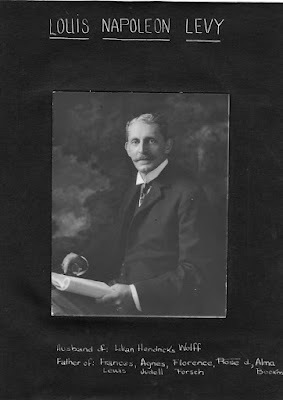
Nancy—like her great-uncleJefferson Levy, her grandfather, and their uncle Uriah P. Levy—lives in New YorkCity. Rob Hoffman was visiting from his home in Michigan.
The day before I had let the folksat Monticello know that the Hoffmans were on their way to the mountaintop for avisit, and the staff gave them a warm welcome. Their guide on the house tour “gavea good spiel,” Nancy later told me in an email, “and he dutifully included theLevys. He even admitted us to the dome [room] and the upstairs [bed] chambers.”
After their special housetour, Rob and Nancy took a walk around the grounds and popped in on anothertour guide, Dick Ruffin as he was concluding a tour in thepost-1809 kitchen located in Monticello’s South Pavilion near the house.
Nancy said that not longafter they joined the group as the tour was ending, Dick Ruffin “launched rightinto the Levy ownership, unprompted.” After he did, Nancy said, “we revealedour connection and he was very excited to have the family on the premises.” Soexcited—and happy—that the guide exclaimed, “Oh, Hallelujah!” when Rob told himthat he and his mother were Levy descendants.
Nancy toldthe group that she remembers the first time she came to Monticello for a visitwhen she was ten years old, and was “mesmerized” when she learned that her motherand her sisters played in the Dome Roomof “Uncle Jeff’s house” when they visited as young children a generationearlier.
Rob posted afour-minute video of Dick Ruffin (below, in the light blue shirt) ending his tour talking about Uriah purchasingMonticello in 1834 and Jefferson Levy selling the property to the ThomasJefferson Foundation a hundred years ago, in December 1923.
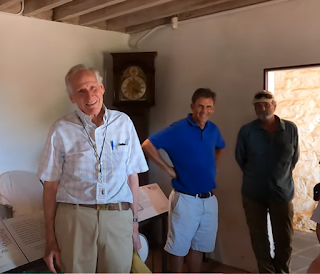
It includeshis reaction to meeting the Hoffmans and his recommendation to them and the groupto “Read Saving Monticello. It’s a book about Uriah Phillips Levy” andthe family’s stewardship of Monticello.
You canwatch the short video at https://bit.ly/ReadSMonticello
The Hoffmans’ visit to the Naval Academy the following day was “extremelyspecial, too,” Nancy Hoffman told me. Jan Zlockie, the administrator of the Friendsof the Jewish Chapel (the nonprofit that raised the funds to build the LevyCenter and Chapel), arranged for them to drive onto and explore the Academy’sgrounds.
“Then we went to Friday nightservices at the chapel (below) and everyone we met bent over backwardsto show us their large collection of Uriah memorabilia.”
At the end of the evening, DavidHoffberger, the USNA’s Chapel Facilities Manager, had a surprise for theHoffmans. He “took us to a closet inside the temple,” Nancy said. Fromthere, he gave us a piece of a wooden fence from Uriah’s time at Monticello. We were thrilled.”
That rare artifact of the Levys’ ownership of Monticello isnow on display in Nancy’s Greenwich Village townhouse, “near my oldest family object,an advertisement for Jonas Phillips’ Philadelphia Vendue Store from 1776,” she said.
THE HUNTLANDBOOK: The University of Virginia Press will be distributing andmarketing my next book, Huntland: TheHistoric Virginia Country House, the Property, and Its Owners, which willbe coming out the first week of September.
It’smy tenth book and my second house history, along the lines of Saving Monticello. Huntland, inMiddleburg, Virginia, was built in 1834, and certainly has lots of history,memorable owners and visitors (including Lyndon Johnson when he was SenateMajority Leader and Vice President), and a triumphant twenty-first centuryhistoric preservation story. Stay tuned for more details.

Here’sthe link for the U-Va. Press Fall Catalog with more info about the book: https://bit.ly/U-VaPressHuntland
EVENTS: I’m in full-time writing mode on another book, a slice-of-lifebiography of Doug Hegdahl, the youngest and lowest-ranking American held as aPOW in Hanoi during the Vietnam War. It will be published by Stackpole Books,most likely next fall. As a result, I don’t have any book talks scheduled for August.
For details on events later this year,check the Events page on my website: https://bit.ly/NewAppearances
GIFT IDEAS: For a personally autographed, brand-new paperback copy of Saving Monticello, please e-mail marcleepson@gmail.com
I also havea few as-new, unopened hardcover copies, along with a good selection of newcopies of my other books: Flag: AnAmerican Biography; Desperate Engagement; What So Proudly We Hailed; Flag: An American Biography; and Ballad of the Green Beret: The Life and Warsof Staff Sgt. Barry Sadler.
July 7, 2023
July 2023
Saving Monticello: The Newsletter
The latest about the book, author events, and more
Newsletter Editor - Marc Leepson
Volume XX, Number 7 July 2023
“The study of the past is a constantly evolving,never-ending journey of discovery.” – Eric Foner

THE MEDAL: While doing the research for my 2005 book, Flag: An American Biography, I learned about—and was fascinated by—whathistorians call the Golden Age of Fraternity of the 1880s and early 1890s.During that time scores of patriotic, veterans, hereditary, and fraternalorganizations came into being, many of which took a keen interest in promotingthe American flag.
Most of the groups established nationalorganizations, augmented with affiliated groups in the states. That included theNational Society of the Sons of the American Revolution, formally establishedon April 30, l889, the l00th anniversary of George Washington’s firstinauguration.
The SAR received itscharter from Congress in l906. It was signed by President Theodore Roosevelt,himself an SAR member.
The SAR, which remains active today, was formed to honor thememory of those who fought in the Revolutionary War. Membership is open only todescendants of those who served in the American military in that war or otherwisesupported the war effort.
TheSAR, which had allowed women to join, changed its policy in 1890 and admittedonly men. That led to the founding on October 11, 1890, of the women-onlyNational Society Daughters of the American Revolution, the DAR.
Jonas Phillipsjoined thePhiladelphia City Revolutionary War Militia as a private in Col. WilliamBradford’s First Battalion 1777, at age 43. Which means that, as I wrote in Saving Monticello, all if his descendants are eligible to be members ofthe SAR and DAR. I didn’t learn that his great grandson Jefferson M. Levybecame an SAR member until five years ago—and wrote about it in thenewsletter’s December 2018 issue at https://bit.ly/SMNesltr
I found out that Jefferson Levy joined the SAR in 1894 after myfriend and colleague Maral Kalbian sent me an image of his SAR application,which she came across while doing research in that time period.
Last month I received another image relatedto J.M. Levy’s SAR membership from Jim Maples of Huntsville, Alabama. Hecontacted me after learning about the Levy family’s role in preservingMonticello and about my book after he bought a rare, late-1890s SAR Membership Medal on eBay.
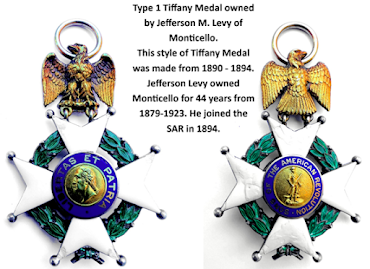
Jim has been collecting antique SARMembership Medals for nearly twenty years, he told me in an email, and saidthat Jefferson Levy’s medal is an extremely rare one, made by Tiffany & Co.from 1890-94.
“Most members have their membershipnumber engraved on the side of one of the arms of the cross on the medal,” Jimtold me in an email. “After wearing it for a couple of years, I remembered thatit didn’t have a membership number, but rather someone’s name engraved.” Saidsomeone: none other than Jefferson M. Levy.
What’s more, Levy had “Of Monticello” engraved on the other side, as you cansee in the above photo. “I had no idea who Jefferson M. Levy was,” Jim told me,“but I began to do a little research and quickly discovered that he and hisuncle had owed Monticello for some 89 years.” Which led JimMaples to Saving Monticello, todonating a copy of the book to the SAR Library in Louisville, and tosubscribing to this newsletter—and kindly giving me permission to use theimages.
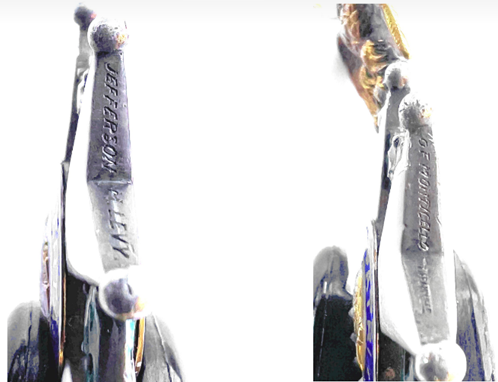
THEHUNTLAND BOOK: As I mentioned last month, the University ofVirginia Press will be distributing and marketing my next book, Huntland: The Historic Virginia CountryHouse, the Property, and Its Owners, which will be coming out in August.
It’smy tenth book and my second house history, along the lines of Saving Monticello. Huntland, inMiddleburg, Virginia, where I live in the Northern Virginia Piedmont, was builtin 1834, and certainly has lots of history, memorable owners, and a triumphant twenty-firstcentury historic preservation story. Stay tuned for more details.
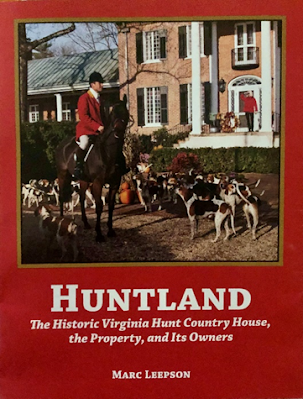
Here’sthe link for the U-Va. Press Fall Catalog with more info about the book: https://bit.ly/U-VaPressHuntland
EVENTS: I’m in full-time writing mode on another book, a slice-of-lifebiography of Doug Hegdahl, the youngest and lowest-ranking American servicemember held as a POW in Hanoi during the Vietnam War, which will be publishedby Stackpole Books, most likely next year. That's Doug after and during his two-year-plus years in the Hanoi Hilton. So, no book talksscheduled for July.

For details on other upcoming events, checkthe Events page on my website: https://bit.ly/NewAppearances
GIFT IDEAS: For a personally autographed, brand-new paperback copy of Saving Monticello, please e-mail marcleepson@gmail.com
I also havea few as-new, unopened hardcover copies, along with a good selection of newcopies of my other books: Flag: AnAmerican Biography; Desperate Engagement; What So Proudly We Hailed; Flag: An American Biography; and Ballad of the Green Beret: The Life and Warsof Staff Sgt. Barry Sadler.
The SMNewsletter on Line: You can read back issues of thisnewsletter at http://bit.ly/SMOnline
July 20232
Saving Monticello: The Newsletter
The latest about the book, author events, and more
Newsletter Editor - Marc Leepson
Volume XX, Number 7 July 2023
“The study of the past is a constantly evolving,never-ending journey of discovery.” – Eric Foner

THE MEDAL: While doing the research for my 2005 book, Flag: An American Biography, I learned about—and was fascinated by—whathistorians call the Golden Age of Fraternity of the 1880s and early 1890s.During that time scores of patriotic, veterans, hereditary, and fraternalorganizations came into being, many of which took a keen interest in promotingthe American flag.
Most of the groups established nationalorganizations, augmented with affiliated groups in the states. That included theNational Society of the Sons of the American Revolution, formally establishedon April 30, l889, the l00th anniversary of George Washington’s firstinauguration.
The SAR received itscharter from Congress in l906. It was signed by President Theodore Roosevelt,himself an SAR member.
The SAR, which remains active today, was formed to honor thememory of those who fought in the Revolutionary War. Membership is open only todescendants of those who served in the American military in that war or otherwisesupported the war effort.
TheSAR, which had allowed women to join, changed its policy in 1890 and admittedonly men. That led to the founding on October 11, 1890, of the women-onlyNational Society Daughters of the American Revolution, the DAR.
Jonas Phillipsjoined thePhiladelphia City Revolutionary War Militia as a private in Col. WilliamBradford’s First Battalion 1777, at age 43. Which means that, as I wrote in Saving Monticello, all if his descendants are eligible to be members ofthe SAR and DAR. I didn’t learn that his great grandson Jefferson M. Levybecame an SAR member until five years ago—and wrote about it in thenewsletter’s December 2018 issue at https://bit.ly/SMNesltr
I found out that Jefferson Levy joined the SAR in 1894 after myfriend and colleague Maral Kalbian sent me an image of his SAR application,which she came across while doing research in that time period.
Last month I received another image relatedto J.M. Levy’s SAR membership from Jim Maples of Huntsville, Alabama. Hecontacted me after learning about the Levy family’s role in preservingMonticello and about my book after he bought a rare, late-1890s SAR Membership Medal on eBay.

Jim has been collecting antique SARMembership Medals for nearly twenty years, he told me in an email, and saidthat Jefferson Levy’s medal is an extremely rare one, made by Tiffany & Co.from 1890-94.
“Most members have their membershipnumber engraved on the side of one of the arms of the cross on the medal,” Jimtold me in an email. “After wearing it for a couple of years, I remembered thatit didn’t have a membership number, but rather someone’s name engraved.” Saidsomeone: none other than Jefferson M. Levy.
What’s more, Levy had “Of Monticello” engraved on the other side, as you cansee in the above photo. “I had no idea who Jefferson M. Levy was,” Jim told me,“but I began to do a little research and quickly discovered that he and hisuncle had owed Monticello for some 89 years.” Which led JimMaples to Saving Monticello, todonating a copy of the book to the SAR Library in Louisville, and tosubscribing to this newsletter—and kindly giving me permission to use theimages.

THEHUNTLAND BOOK: As I mentioned last month, the University ofVirginia Press will be distributing and marketing my next book, Huntland: The Historic Virginia CountryHouse, the Property, and Its Owners, which will be coming out in August.
It’smy tenth book and my second house history, along the lines of Saving Monticello. Huntland, inMiddleburg, Virginia, where I live in the Northern Virginia Piedmont, was builtin 1834, and certainly has lots of history, memorable owners, and a triumphant twenty-firstcentury historic preservation story. Stay tuned for more details.

Here’sthe link for the U-Va. Press Fall Catalog with more info about the book: https://bit.ly/U-VaPressHuntland
EVENTS: I’m in full-time writing mode on another book, a slice-of-lifebiography of Doug Hegdahl, the youngest and lowest-ranking American servicemember held as a POW in Hanoi during the Vietnam War, which will be publishedby Stackpole Books, most likely next year. That's Doug after and during his two-year-plus years in the Hanoi Hilton. So, no book talksscheduled for July.

For details on other upcoming events, checkthe Events page on my website: https://bit.ly/NewAppearances
GIFT IDEAS: For a personally autographed, brand-new paperback copy of Saving Monticello, please e-mail marcleepson@gmail.com
I also havea few as-new, unopened hardcover copies, along with a good selection of newcopies of my other books: Flag: AnAmerican Biography; Desperate Engagement; What So Proudly We Hailed; Flag: An American Biography; and Ballad of the Green Beret: The Life and Warsof Staff Sgt. Barry Sadler.
The SMNewsletter on Line: You can read back issues of thisnewsletter at http://bit.ly/SMOnline
June 9, 2023
June 2023
Saving Monticello: The Newsletter
The latest about the book, author events, and more
Newsletter Editor - Marc Leepson
Volume XX, Number 6 June 2023
“The study of the past is a constantly evolving,never-ending journey of discovery.” – Eric Foner

IN HALLOWED REPOSE: Visitors to Monticello who take in the fenced-in Jefferson familygraveyard about 2,000 feet from the house often presume that the small cemeteryconveyed with the property when Jefferson’s heirs sold Monticello. But that isnot the case.
The graveyard, containing Thomas Jefferson’sgravesite and plots of many of his descendants and their families, was retainedby the family after they sold Monticello to James Turner Barclay in 1831, fiveyears after his death. The family continued to maintain and preserve the graveyardafter Barclay sold Monticello to Uriah Levy in 1834, when Jefferson Monroe Levytook control in 1879, and when he sold the property to the Thomas JeffersonMemorial Foundation in 1923.
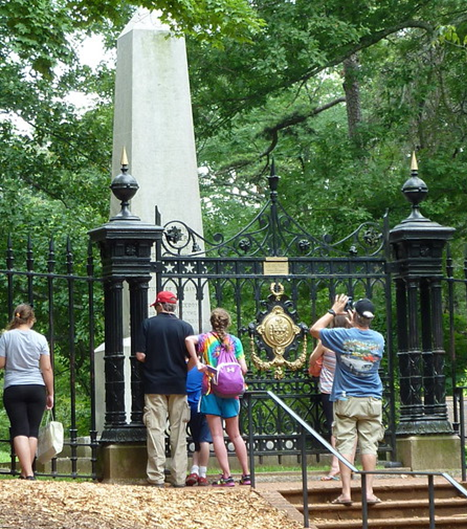 Since 1913, the graveyard has come underthe purview of the Monticello Association, a nonprofit founded that year. Mostof its members are lineal descendants of Thomas Jefferson.
Since 1913, the graveyard has come underthe purview of the Monticello Association, a nonprofit founded that year. Mostof its members are lineal descendants of Thomas Jefferson. Which brings us to a bit of drama surrounding Thomas Jefferson’sgrave that I just learned about—although it happened in 1882. I discovered itwhile searching the Library of Congress’ Chronicling America historic newspaperarchive, which contains hundreds of thousands of searchable digitized images ofnewspapers (mainly, but not exclusively, small and medium-sized city newspapers)from 1770-1963.
As I was searching for potential materialto use in this newsletter, I happened upon a few articles about a kerfuffle instigatedin 1882 by Thomas Jefferson’s oldest surviving grandchild, Septimia, so named becauseshe was the seventh (and last) daughter of Thomas Jefferson’s daughter MarthaRandolph and her husband Thomas Mann Randolph.
Septimia Anne Randolph, was born on January 3, 1814, and grew up at Monticello. Notlong after Thomas Jefferson died in 1826, she moved to Boston with her motherand younger brother George where she continued her education at the home of herolder sister Ellen, who had married Joseph Coolidge and moved north with him toMassachusetts.
Septimiaspent the next ten years living with relatives and family friends back home inVirginia, in Washington, D.C., Louisiana, Florida, and in Havana, Cuba. Whilein Havana, she met a Scottish doctor, David Scott Meikleham. They married onAugust 13, 1838, at the Randolph family’s Edgehill Plantation near Monticello,then moved to Havana.
The couplesettled in New York City, where Dr. Meikleham practiced medicine until hisdeath on November 20, 1849. His early demise was a financial burden to Septimiaand her four children. To make ends meet, she ran a boardinghouse, then left NewYork to return to Edgehill, and then moved to Washington, D.C., where she lived,as one newspaper reported, with three of her “middle-aged” children “in ahumble cottage” in Georgetown, “which rents for $20 a month.” She died in Washingtonat age 73, on September 14, 1887.
Septimia Meikleham (in portrait below) made national headlines in thespring of 1882 when she announced that, as Jefferson’s oldest directdescendant, she’d decided that her grandfather’s remains should be disinterredfrom the family gravesite on the mountaintop in Charlottesville and reburied inGlenwood Cemetery in Northeast Washington, D.C. Glenwood, not far from the present-day WashingtonHospital Center, is the site ofthe early 19th century Clover Hill Farm, which became a cemetery in1854 and remains one today.
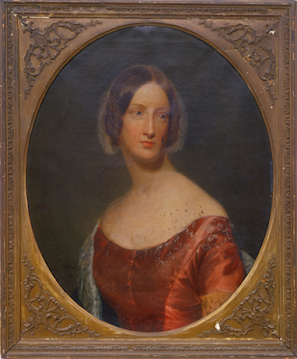
The reason for the move, Septimia said, wasthat the Monticello graveyard had “passed out of control of the family” threeyears earlier, in 1879, when Jefferson Monroe Levy settled a family lawsuitover Uriah Levy’s will and took ownership of the property. That simply was nottrue as the graveyard never conveyed with the property and remained in thehands of the descendants of her brother, Thomas Jefferson Randolph.Nevertheless, the Glenwood Cemetery Board of Trustees agreed to acceptJefferson’s remains at its June 1882 annual meeting.
The backlash came a few days after the meetingwhen the heirs of Thomas Jefferson Randolph (who had died in 1875), theco-executor of his grandfather’s will, hired an attorney to oppose the move.The heirs “will not allow Jefferson’s remains to be moved to another cemetery,”the attorney wrote to the Glenwood board. He also pointed out that thegraveyard did not convey with the sale of Monticello, and that T.J. Randolph’s heirs—notSeptimia—owned and managed the site.
To his credit, Jefferson Monroe Levy spokeout forcefully against Septimia Meikleham’s proposal. He was quoted at length in several newspapers giving the historyof the graveyard and making it clear he strongly opposed moving the ThomasJefferson’s remains from the place where he let it be known he wanted to restin peace.
“The spot where Jefferson was buried wasselected by himself,” Levy said, “and there are peculiar reasons why his wishesshould be respected. When Jefferson and [his close friend and brother-in-law]Dabney Carr were young men, they made an agreement that whichever of them shoulddie first should be buried by the survivor under a certain oak tree atMonticello, which was a favorite with them both.
“Dabney Carr died in France, in the time ofthe Revolutionary War, and after the war was over, Jefferson, in accordancewith his agreement, had the body of Carr brought to this country and buriedunder the oak. When Jefferson died, he expressed in his will his desire to beburied in the same secluded spot beside his friend. He also left directions asto the monument to be erected over him.
“His wife and children were buried in thesame spot of ground. The Randolph family has used it as burying ground eversince.”
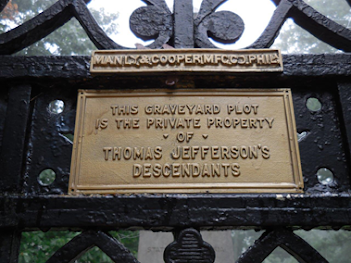
Newspapers throughout the country agreedwith the other descendants and with Jefferson Levy, and editorialized againstthe move, some of them intimating that Septimia pushed for the move forfinancial gain. The St. Paul (Minnesota) DailyGlobe, for example, editorialized on June 18, 1882, that Thomas Jefferson had“the wish that his remains might rest forever undisturbed, and it was only leftfor modern, mercenary ghouls to prepose to desecrate the hallow burial lot atMonticello.”
The editorial concluded: “Would itbe anything short of sacrilege to remove from ground so hallowed, selected byhimself, for any purpose, and especially for a mercenary one, the remains ofthe venerated patriot, philosopher and statesman? Let the remains restundisturbed, in hallowed repose, ‘until the last syllable of recorded time.’”
The Glenwood Board took the hint anddropped the matter.
HOUSE HISTORY NO. 2: If yougo to the University of Virginia Press Fall 2023 catalog online and scroll downthe left side, you’ll get a preview of my next book. Huntland: The Historic Virginia Country House, the Property, and ItsOwners, which will be coming out in August. It’s my tenth book and mysecond house history, along the lines of SavingMonticello. Huntland, in Middleburg, Virginia, was built in 1834, andcertainly has lots of history, memorable owners, and a triumphant 21stcentury historic preservation story. Stay tuned for more details.
Here’sthe link for the U-Va. Press Fall Catalog; https://www.upress.virginia.edu/fall23.pdf
EVENTS: Just one in June, a talk on my only Civil War book, Desperate Engagement, the story of thelittle-known but crucial July 11, 1864, Battle of Monocacy near Frederick,Maryland, and Confederate Gen. Jubal Early’s subsequent attack on Washington,D.C., that takes place on Saturday, June17, for the Alexandria (Va.) Civil War Roundtable.
For details on other upcoming events, checkthe Events page on my website: https://bit.ly/NewAppearances
GIFT IDEAS: For a personally autographed, brand-new paperback copy of Saving Monticello, please e-mail marcleepson@gmail.com I also have a few as-new, unopened hardcovercopies, along with a good selection of new copies of my other books: Flag: An American Biography; DesperateEngagement; What So Proudly We Hailed; Flag:An American Biography; and Ballad ofthe Green Beret: The Life and Wars of Staff Sgt. Barry Sadler.

